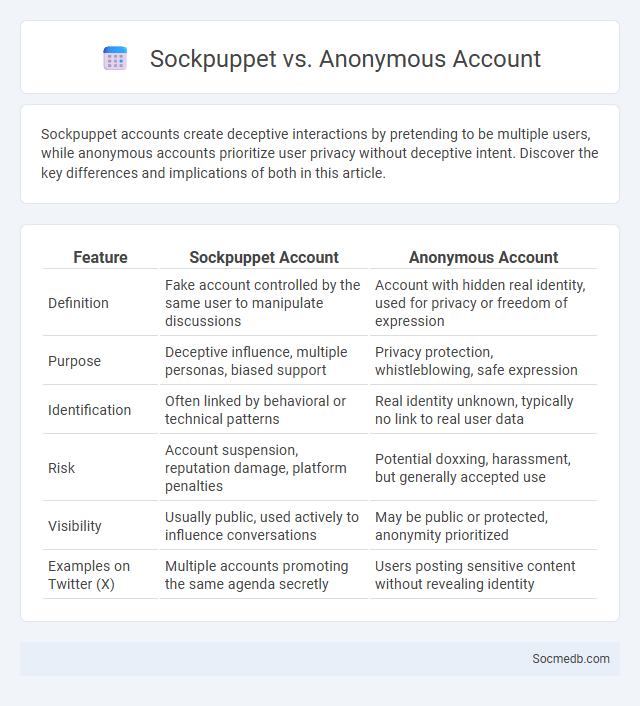
Photo illustration: Sockpuppet vs Anonymous Account
Sockpuppet accounts create deceptive interactions by pretending to be multiple users, while anonymous accounts prioritize user privacy without deceptive intent. Discover the key differences and implications of both in this article.
Table of Comparison
| Feature | Sockpuppet Account | Anonymous Account |
|---|---|---|
| Definition | Fake account controlled by the same user to manipulate discussions | Account with hidden real identity, used for privacy or freedom of expression |
| Purpose | Deceptive influence, multiple personas, biased support | Privacy protection, whistleblowing, safe expression |
| Identification | Often linked by behavioral or technical patterns | Real identity unknown, typically no link to real user data |
| Risk | Account suspension, reputation damage, platform penalties | Potential doxxing, harassment, but generally accepted use |
| Visibility | Usually public, used actively to influence conversations | May be public or protected, anonymity prioritized |
| Examples on Twitter (X) | Multiple accounts promoting the same agenda secretly | Users posting sensitive content without revealing identity |
Introduction: Understanding Online Personas
Online personas shape how social media users present themselves, influencing personal branding and audience perception. Understanding the construction of these digital identities helps you navigate authenticity and privacy while engaging with diverse platforms. Mastering the nuances of online personas enhances both social interactions and professional opportunities in the digital world.
Defining Sockpuppet Accounts
Sockpuppet accounts are fake online identities created to manipulate public opinion or deceive others on social media platforms. These accounts often mimic genuine users to spread misinformation, amplify certain viewpoints, or engage in coordinated campaigns without revealing their true origin. Understanding how sockpuppet accounts operate helps you identify inauthentic behavior and maintain a trustworthy digital environment.
What is an Anonymous Account?
An anonymous account on social media allows you to interact, post, or browse without revealing your true identity, helping protect your privacy and personal information. These accounts typically avoid using real names, photos, or identifiable details, enabling users to express opinions freely or follow content discreetly. Maintaining anonymity can shield you from targeted ads, harassment, or unwanted attention, enhancing your online security.
Key Differences: Sockpuppet vs Anonymous Account
Sockpuppet accounts are created to deceive others by pretending to be different people, often used for manipulating opinions or inflating support online. Anonymous accounts prioritize user privacy without necessarily aiming to mislead, enabling free expression without revealing personal identity. The key difference lies in intent: sockpuppets involve deceptive impersonation, while anonymous accounts focus on privacy and anonymity.
Motivations Behind Using Sockpuppets
Users create sockpuppets to manipulate online discourse, protect anonymity, or promote specific agendas without direct association. These false identities often serve to inflate support, harass others, or bypass platform restrictions. Understanding the motivations behind sockpuppet use reveals patterns of deceptive behavior crucial for improving digital trust and content authenticity.
The Role of Anonymity on the Internet
Anonymity on the Internet allows users to express opinions and share information without fear of judgment or repercussions, fostering open communication and creativity. This protection enhances privacy but can also enable harmful behaviors like cyberbullying and misinformation. Understanding how your anonymity impacts both personal freedom and responsibility is crucial for navigating social media safely and effectively.
Detecting Sockpuppet Activities
Detecting sockpuppet activities on social media involves analyzing user behavior patterns, such as the synchronization of posting times, similarities in language use, and IP address tracking to identify duplicate accounts managed by the same entity. Advanced machine learning algorithms and natural language processing (NLP) techniques enable platforms to uncover coordinated inauthentic behavior and mitigate misinformation spread. Real-time monitoring systems enhance detection accuracy by correlating metadata and interaction networks to expose hidden sockpuppet networks effectively.
Ethical Concerns and Platform Policies
Social media platforms face critical ethical concerns including data privacy, misinformation spread, and user manipulation, prompting stricter platform policies. Companies like Facebook, Twitter, and TikTok implement content moderation, transparent data practices, and community guidelines to address hate speech and fake news. Regulatory frameworks such as GDPR and CCPA influence platform policies by enforcing user consent and data protection measures.
Impact on Online Communities
Social media significantly shapes online communities by fostering real-time interaction, enabling diverse voices to connect across global boundaries. Your engagement influences group dynamics, promoting collaboration, shared interests, and the rapid spread of information or trends. This digital environment transforms how communities form, evolve, and sustain relationships, impacting social cohesion and collective identity.
Best Practices for Account Transparency
Maintaining account transparency on social media involves clearly displaying verified information such as official contact details, profile ownership, and content sources to build user trust and authenticity. Using features like verified badges, detailed bios, and consistent branding helps ensure followers can easily recognize legitimate accounts and distinguish them from impersonators or fake profiles. Regularly updating privacy policies and disclosing partnerships or sponsored content aligns with platform guidelines and enhances credibility.
 socmedb.com
socmedb.com